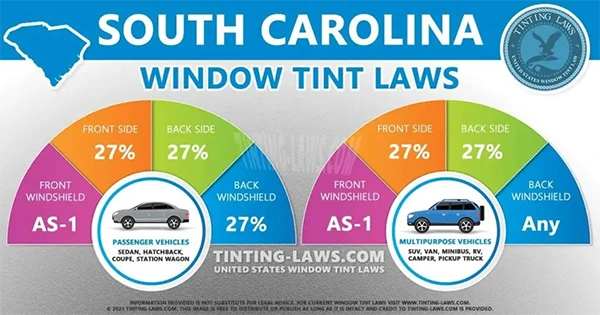Window tinting is one of the most popular customizations in cars. Not only does it look good, but it is also useful. You must’ve heard people saying ‘Stay Cool, Stay Tinted’ but in many states applying shades is illegal, and you can face legal consequences for it and that won’t be cool
There are reasons why these types of customizing are illegal, it can reduce the visibility of the driver, causing accidents and crimes that could easily be committed. If you are from South Carolina, then you should be navigating South Carolina car window tint laws.
In this article, we’ll learn about all the laws related to window tinting in South Carolina, so read carefully if you don’t want to get in any legal trouble.
South Carolina regulates the darkness of a vehicle’s window blinds. The law also differs depending on the type of vehicle. The darkness of the tint refers to how much light is allowed to pass through the film. In other words, how clearly you can see inside a vehicle from the outside.
Why does the Palmetto State regulate window tint darkness? The primary reason comes down to safety. Even though drivers and vehicle passengers can see outside the door frames without any issues, it’s different for those not in the automobile.
When a law enforcement officer can’t see inside a vehicle they pull over, it can increase the risk of an incident. The officer may mistakenly believe that the vehicle’s passengers are posing a threat even if it’s not true. To help avoid potential issues and improve everyone’s safety, window shade darkness is strictly regulated.

You can’t darken the windshield of a passenger car or any type of sedan. There aren’t any exceptions to this law. However, you can customize the front and back side flaps. The rear window can also be customized.
The law regarding window covering darkness for trucks and SUVs is similar. You can’t laminate the vehicle’s front windshield, and more than 27% of light must be let in if the front side panels are coated.
When it comes to the back side and rear windows, you can have fun and experiment with different levels of darkness. South Carolina doesn’t regulate
Casement cover on the rear side and back windows. If you’re wondering shy, it’s usually because these windows are higher off of the ground and already difficult for anyone to see inside the vehicle even if the aperture isn’t tinted.
What happens if your window tint is too dark? Chances are you’ll receive a ticket for a non-moving violation and an order to remove the drapery blinds. Don’t worry about the ticket affecting your car insurance rates. Since it’s a non-moving violation, the ticket usually doesn’t show up on your driving record.

Not all window tinting is reflective, but if you go with this option, South Carolina has laws in place. These laws regulate how reflective aperture tint can be on passenger cars, SUVs, and pickup trucks.
Reflective window shades are a popular option in some states. The dark color reflects heat and glare. Your vehicle stays a little cooler with a reflective tint and the sun’s glare isn’t as bright. This can help eliminate safety concerns that pop up when the sun’s in your eyes.
Don’t forget that you can’t tint your vehicle’s front windshield, even if the film is non-reflective. The front side windows can have window tint, but it must be non-reflective—this applies whether you’re driving a sedan, truck, or SUV.
Okay, so you can’t apply reflective light-catching tint to the front of any vehicle, but what about the rear side and back fenestella? Guess what, the law is the same for the back casement as the front. In other words, state law doesn’t allow for the use of reflective window tint.
FUN FACT
Window tinting can block up to 99% of harmful UV rays.
Even though you can’t legally apply reflective window tint, you can still darken your vehicle’s casement. Just remember to leave the front windshield alone. Tinting has its advantages, and we covered some of them.
The reflective coating can help keep your vehicle cooler, which is always a welcome advantage during the summer. The color, even if it’s non-reflective, can help reduce some of the sun’s glare. You’ll probably still need to wear sunglasses on bright days, but UV protection can also help.
Don’t forget about shading your vehicle’s interior from the sun. Everything from your dashboard to the seat coverings can start to fade over time. Window blinds may be able to prevent this problem, or at least slow it down.
Also Read: UK Passes Law Letting Regulators Fine Big Tech Giants
